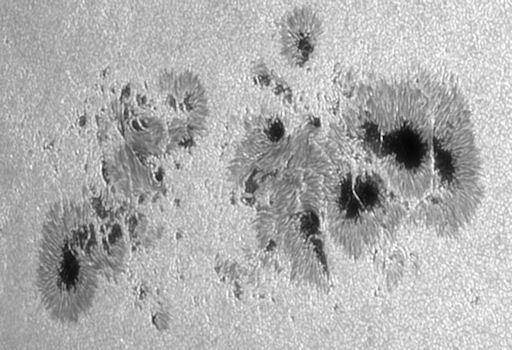Turn your cell phone into a field-tested satellite tracker. Works for Android and iPhone. | | |
POLAR BLAST: A magnetic filament curling around the sun's north pole erupted during the early hours of Nov. 5th. Material propelled by the blast is heading out of the plane of the solar system and will not impact any planet. [SDO movie]
BIG SUNSPOT: Sunspot AR1339 has quieted since Nov. 3rd when it unleashed an X2-class solar flare. Nevertheless, it still poses a threat for powerful eruptions. The behemoth sunspot has a "beta-gamma-delta" magnetic field that harbors energy for more X-flares. Eruptions this weekend could be Earth-directed as AR1339 turns toward our planet. Solar flare alerts: text, voice.
AR1339 is one of the largest sunspots in years, and it looks spectacular though backyard solar telescopes. Eric Roel took this picture yesterday from his private observatory in Valle de Bravo, México:

Each of the primary dark cores is about the size of Earth, and the entire group sprawls more than 100,000 km from end to end. The sunspot is so big, it's starting to attact the attention of people looking into the sunset.
more images: from Monika Landy-Gyebnar of Urkut, Hungary; from Vladimir Zivkovic of Djakovo, Croatia; from Chris Schur of Payson, Arizona; from Juan Jose Ortiz of Metepec, Mexico; from Mariano Ribas of Buenos Aires, Argentina; from Philippe Van den Doorn of Rixensart, near Brussels, Belgium; from Peter Paice of Belfast, Northern Ireland;
NORTHERN LIGHTS: Last night sky watchers in Scandinavia witnessed a vivid display of green auroras. It was so bright, even the rocks and water got involved:

"After weeks with rain and overcast, it was good to see the auroras again," says photographer Helge Mortensen of Kvaløya, Norway. "An exposure time of only 4 to 5 seconds was sufficient to reveal the water's green cast."
The display was caused by the interplanetary magnetic field (IMF), which tipped south and partially canceled Earth's own north-pointing field. This created a crack in Earth's magnetosphere; solar wind flowed in to fuel the auroras. Aurora alerts: text, voice.
more images: from Ole C. Salomonsen of Tromsø, Norway, from Frank Olsen of Blokken, Norway; from Sindre Nedrevåg of Bodoe, Norway; from the DMSP F18 satellite in Earth orbit
October 2011 Aurora Gallery
[previous Octobers: 2010, 2009, 2008, 2007, 2006, 2004, 2003, 2002]

